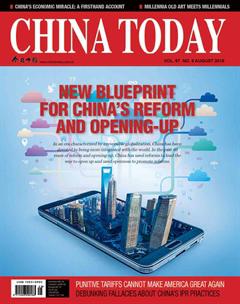society
White Paper Shows China Observes WTO Rules
China released a white paper titled “China and the World Trade Organization” on June 28, reiterating that it pursues a mutually beneficial trade strategy and that it will continue to open up in “a more comprehensive, profound, and diversified way.”
The document provides ample examples and data showing the measures China has taken to observe and uphold WTO rules. It fully demonstrates support for a multilateral trading system that is open, transparent, inclusive, and nondiscriminatory.
The white paper says China has revised the catalog for the Guidance of Foreign Investment Industries twice over the past five years, reducing restrictive measures on foreign investment by 65 percent.
Since becoming a WTO member in 2001, China has comprehensively honored its tariff reduction commitments, upgraded its tariff catalog, and improved the tariff structure. From 2001 to 2017, Chinas imports in goods jumped from US $243.6 billion to US $1.84 trillion, with an average annual growth of 13.5 percent, making the country the worlds second-largest importer.
China issued a new “negative list” on June 28 that sets out which of its industries are closed to foreign investors. It cuts the restrictions from 63 to 48, especially in the service industry, infrastructure, railway passenger transport, international shipping, grain purchases, and wholesale goods trade.
Seawater Hybrid Rice to Be Planted Nationwide by 2020
Chinese agricultural scientist Yuan Longping announced recently that his team has completed detailed plans for seawater hybrid rices trial planting and promotion. The new generation hybrid rice will first be planted on an experimental basis in six provinces in China and is expected to be promoted across the country by 2020, said Yuan.
Yuan and his team have successfully planted seawater hybrid rice in east Chinas Shandong Province, setting a record production of 500 kilograms per mu(0.07 hectare). Recently, the same rice was also successfully planted and resulted in a harvest of 500 kilograms per mu in Dubai, the United Arab Emirates. It was the first time in the world that rice was successfully planted in the tropics.
Molecular technology was used in the breeding of the third generation super hybrid rice, according to Yuan, who is an academician of the Chinese Academy of Engineering. Statistics show that there is about 200 million mu of saline-alkaline soil in China that is suitable for the newly developed hybrid rice.
Public Health Improved
A report from the National Health Commission shows that last year the average life span of the Chinese population increased to 76.7 years from 76.5 years of 2016, and infant mortality and maternal mortality rates dropped from 7.5 percent to 6.8 percent, and from 19.9 to 19.6 per 100,000 respectively. The health conditions of the Chinese population are, in general, above the average level of upper middle-income countries. Last year the number of visits by out-patients rose by 3.2 percent year on year to 250 million, and medical expenses dropped thanks to reforms in public hospitals. By the end of 2017, 93.9 percent of public hospitals in urban areas had scrapped medicine markups. Meanwhile, by cultivating more general practitioners and improving services, community clinics have seen an increase in patient visits, which totaled 4.43 billion in 2017, a rise of 60 million from 2016.
Better IP Protection
June marked the 10th anniversary of the Outline of the National Intellectual Property Strategy issued by the State Council. The outline is the bedrock regulatory document for Chinas intellectual property protection.
Yan Junqi, president of the Central Institute of Socialism, said China has paid more attention to intellectual property protection in the past five years, and IP related industries are seeing unprecedented opportunities for growth.
In the past decade, the number of patents from the Chinese mainland grew from 96,000 in 2007 to 1.3 million in 2017, ranking it third in the world just behind the U.S. and Japan, according to the State Intellectual Property Office.
In the last five years, China has investigated and dealt with more than 190,000 cases of patent infringement and 170,000 cases of trademark infringement. China also established specific courts to deal with intellectual property rights.
As more Chinese patents and companies compete on the world stage, Chinas intellectual property protection will become stricter, more comprehensive and responsive, as well as better coordinated across different agencies.
China will devote more resources to producing high-value, influential brands and patents, and participate in the global governance of intellectual property to help it become more inclusive, balanced, and efficient.

